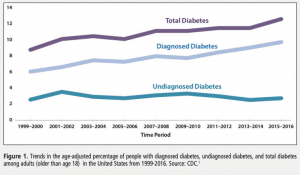Hearing Loss and Diabetes
Recent studies have linked Hearing Loss to a rise in Diabetes.
An estimated 30.3 million people in the United States have diabetes, but only 23.1 million of these people have diagnosed diabetes; the other 7.2 million are undiagnosed.
It’s easy to see if hearing loss, vestibular disorders, and other hearing-related problems serve as possible early-warning signs for diabetes.
Figure 1 shows CDC estimates for the growing prevalence of diabetes among adults. For the period of 2013-2016, the total diabetes prevalence was 12%, up from 9.5% in 1999-2002. This same trend can be observed in the county-by-county analysis by the CDC shown in Figure 2. In 2016, estimates of diagnosed diabetes prevalence varied across US counties, ranging from 1.5% to 33.0%
3 theories for why hearing loss and diabetes are linked:
- Vascular degradation due to high blood pressure.
- Diabetes-related damage to neurons which carry auditory information to the brain.
- Ototoxicity of medications for treating diabetes.

Hearing Care improves health and reduces costs for those with Diabetes
The Cost
The report, Economic Costs of Diabetes in the US in 2017, 16 was commissioned by the American Diabetes Association. Highlights from this study include17:
- The total estimated 2017 cost of diagnosed diabetes was $327 billion, which includes $237 billion in direct medical costs and $90 billion in reduced productivity.
- For the cost categories analyzed, care for people with diagnosed diabetes accounts for 1 in 4 US healthcare dollars, and more than half of that expenditure is directly attributable to diabetes.
- People with diagnosed diabetes have average medical expenditures of $16,752 per year, of which about $9,601 is attributed to diabetes.
- 67.3% of the costs for diabetes care is provided by government insurance (ie, Medicare, Medicaid, and the military). The rest is paid for by private insurance (30.7%) or by the uninsured (2%).
- The major components of spending on diabetes healthcare is for hospital inpatient care (30% of the total medical cost), prescription medications to treat complications of diabetes (30%), anti-diabetic agents and diabetes supplies (15%), and physician office visits (13%).
Preventing falls for patients with Diabetes
A 2017 meta analysis found that, across 12 studies, patients with type 2 diabetes were at increased risk for fractures from low-energy falls.14 These falls are ones that occur from standing height, such as might occur if you trip or get dizzy and fall over. Disorders of the inner ear can impact the vestibular system, and researchers have found vestibular dysfunction to be 2.3 times more likely in those with diabetes than in those without it.15 However, over time, the body can often compensate with visual cues or the sense of touch, Spankovich notes. Unfortunately, diabetes is a disease that attacks all the body’s sensory systems at once. Vision may be blurred from diabetic retinopathy. Sensation from the feet may be muted by diabetic neuropathy. And on top of all of that, the patient may experience dizziness from fluctuations in blood sugar levels (hypoglycemia or hyperglycemia) and medications.
Hearing Loss and Associated Comorbidities:
What Do We Know?
In only the last dozen years, many important studies have surfaced linking hearing loss to several disabling chronic conditions, such as diabetes, cognitive decline and Alzheimer’s disease, clinical depression, falls among the elderly, cardiovascular disease, and many more. A webinar and related paper —offered by audiologist and former Department of Veterans Affairs (VA) researcher Harvey Abrams, PhD, reviews several of the most eye-opening of these studies and summarizes their findings so that healthcare professionals can use the information to foster more informed and impactful patient counseling. To view the free webinar, visit: https://www.youtube.com/watch?v=xDr6f2YuKjw
Article originally from The Hearing Reviewhttps://www.hearingreview.com/wp-content/uploads/2020/06/Link-Between-Diabetes-Hearing-Loss.pdf
References
- Centers for Disease Control and Prevention (CDC). National diabetes statistics report, 2020. Atlanta: CDC, US Dept of Health and Human Services; 2020.
- National Institute on Deafness and Other Communication Disorders. Quick statistics about hearing. December 15, 2016. Available at: https://www.nidcd.nih.gov/health/ statistics/quick-statistics-hearing
- Abrams H. Hearing loss and associated comorbidities: What do we know? Hearing Review. 2017;24(12):32-35. Available at: https://www.hearingreview.com/hearing-loss/ hearing-loss-prevention/risk-factors/hearing-loss-associated-comorbidities-know
- American Diabetes Association. Diabetes and hearing loss. Available at: https://www. diabetes.org/diabetes-and-hearing-loss
- Bainbridge KE, Hoffman HJ, Cowie CC. Diabetes and hearing impairment in the United States: Audiometric evidence from the National Health and Nutrition Examination Survey, 1999-2004. Ann Int Med. 2008:149(1);1-10.
- Centers for Disease Control and Prevention. Working together to manage diabetes: A toolkit for Pharmacy, Podiatry, Optometry, and Dentistry (PPOD). February 19, 2016. Available at: https://www.cdc.gov/diabetes/ndep/toolkits/ppod.html
- Verma S. CMS encourages eligible suppliers to participate in expanded Medicare diabetes prevention program model. April 30, 2018. Available at https://www.cms. gov/blog/cms-encourages-eligible-suppliers-participate-expanded-medicare-diabetesprevention-program-model.
- Reed NS, Altan A, Deal JA, et al. Trends in health care costs and utilization associated with untreated hearing loss over 10 years. JAMA Otolaryngol Head Neck Surg. 2019;145(1):27-34.
- Kaufmann L. Hearing and Value-based Healthcare. Hearing Review. 2018. 25(3) [Mar, Suppl]:S1-S8. Available at: https://www.hearingreview.com/hearing-loss/healthwellness/special-report-hearing-care-value-based-reimbursement-medicine
- Goldin A, Weinstein BE, Shiman N. How do medical masks degrade speech perception? Hearing Review. 2020;27(5)[May]:8-9. Available at: https://www. hearingreview.com/hearing-loss/health-wellness/how-do-medical-masks-degradespeech-reception
- Vercammen C, Ferguson M, Kramer SE, et al. Well-hearing is well-being. Hearing Review. 2020;27(3):18-22. Available at: https://www.hearingreview.com/hearing-loss/ patient-care/counseling-education/well-hearing-is-well-being
- Centers for Medicare and Medicaid Services. Trump administration issues second round of sweeping changes to support US healthcare system during COVID-19 pandemic. [Press release.] Apr 30, 2020.
- Gans R. Rethinking treatment of dizzy patients and balance disorders. Hearing Review. 1999;6(4)[Apr]:8-12.
- Jia P, Bao L, Chen H, Yuan J, et al. Risk of low-energy fracture in type 2 diabetes patients: A meta-analysis of observational studies. Osteoporos Int. 2017 Nov;28(11):3113-3121.
- Agrawal Y, Carey JP, Della Santina CC, et al. Diabetes, vestibular dysfunction, and falls: Analyses from the national health and nutrition examination survey. Otol Neurotol. 2010;31:1445-1450.
- American Diabetes Association. Economic Costs of Diabetes in the U.S. in 2017. March 2018. Available at: https://doi.org/10.2337/dci18-0007
- American Diabetes Association. The cost of diabetes. Available at: https://www. diabetes.org/resources/statistics/cost-diabetes
